
“That Terminator is out there!
It can’t be bargained with.
It can’t be reasoned with.
It doesn’t feel pity, or remorse, or fear.
And it absolutely will not stop, ever, until you are dead.”
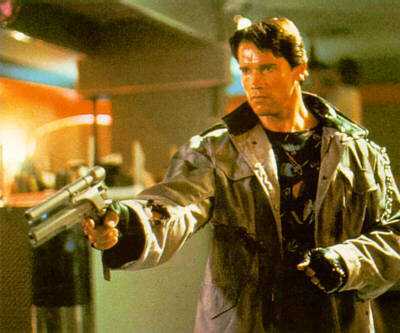
James Cameron introduced a complex saga of time travel, impending destruction of all society, and battle against futuristic robots in the 1984 Terminator. Made for a mere $US6.4 million, the movie was a surprise hit that grossed $US36.9 million and made a star out of the then relatively unknown Arnold Schwarzenegger and capitalized on many of the stars of Cameron’s other smash hit, Aliens.
Schwarzenegger portrayed a T-800 terminator cyborg who traveled from the year 2029 to 1984 to assassinate Sarah Conner (Linda Hamilton), mother of the future and still unborn post-holocaust warlord, John Conner. Rushing behind the assassin robot came Kyle Reese (Michael Biehn), intent on protecting Sarah at all costs. The conflict didn’t involve just the main characters. It was a fight for the survival of all mankind.
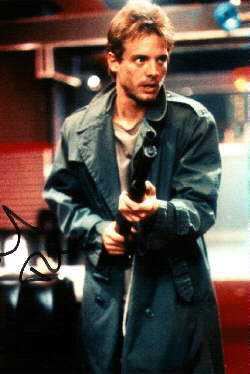
Kyle was sent by the elder John Conner through the same time machine used by the T-800 which was supposed to be destroyed after his passing. Kyle and Sarah battled the cyborg through the streets of Los Angeles, eventually destroying him in a factory.
Throughout the dialog and flash-forward scenes, we learn that the devastated Earth was demolished by a computer network called Skynet, that determined mankind was a threat and sought man’s ultimate destruction, temporarily sparing a few to be used for manual labor. John Conner led the resistance that saved mankind and led to the fall of the machines.
The Terminator had arrived to change all that, and it had failed.
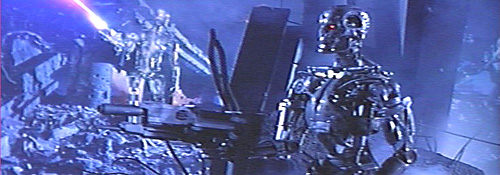
Comments: The special effects for Terminator differed drastically from the Star Wars imitations popular at the time. Their future was a dark future, with a mix of conventional and futuristic weaponry and devices. Although simplistic by modern standards, the effects for Terminator were stunning for the time. Among the key effects at the time were the computerized displays seen through the eyes of the terminator. Those displays actually showed a series of Apple 2 assembly code and Cobol.
TERMINATOR 2: JUDGMENT DAY
In 1991, the story was continued with the sequel, Terminator 2: Judgment Day. In this yarn, Arnold Schwarzenegger returned as another T-800 Terminator. In contrast to his first role, in this sequel he was sent to protect a young John Connor (Edward Furlong) from a new robotic assassin, the T-1000 (Robert Patrick). This new killer robot was constructed from a mimetic polyalloy, having the ability to take on the form of practically any object or person it contacted.
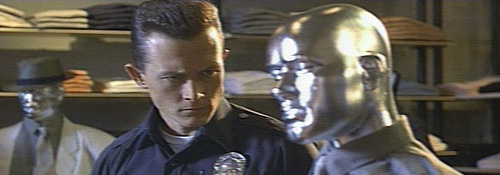
In this story, we also learn that Sarah Conner has has single-handedly opted to wage the war to stop the future holocaust she’s convinced will come, allying herself with combat specialists and the fringes of society to ward off the industrial developments that will lead to Judgement Day. During an attempted bombing, she was arrested and placed in mental institution. With the help of John and the T-800, she escapes and the three become refugees who flee to Mexico.
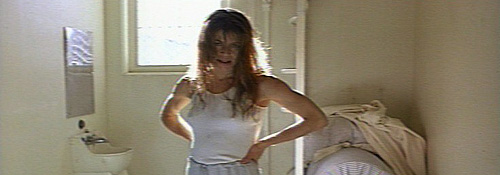
Sarah soon learns that Miles Dyson (Joe Morton), one key scientist working for the Cyberdyne Systems’ Special Projects Division, is the man responsible for the creation of the first cybernetic defense system, the very system that later launches the nuclear attacks against mankind. Sarah first attempts to kill Dyson but is stopped before she completes the act.
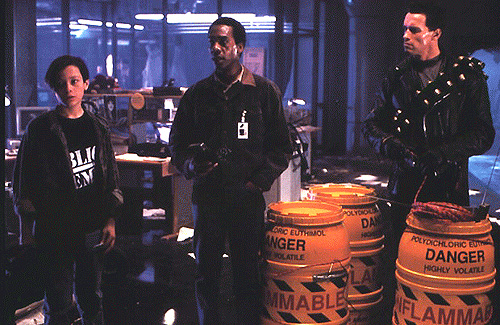
Within the night, she, John, and the T-800 convince him that he has started the path to the end of the world. He joins them in a strike against the Cyberdyne lab, designed to destroy the progress made and prevent SkyNet from becoming a reality. They are detected during their break-in at SkyNet and tracked by the T-1000. There is an intense showdown, which ends with Dyson getting horribly shot and then setting off explosive charges at the moment of his death as the three escape with the T-1000 on their trail.
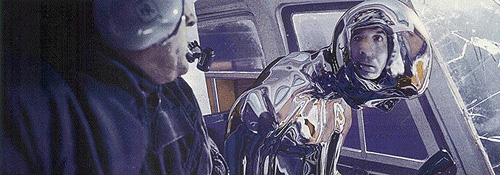
The more advanced Terminator chases them an operational steel mill where they have their last showdown with the T-1000, eventually driving it into a vat of boiling metal. John Conner tosses the robotic arm and stolen CPU chip into the same vat before reluctantly lowering the second T-800 into the same mass of boiling metal. Humanity seems to be saved. The holocaust and devastating attacks against mankind are averted.
Comments: Terminator 2 also ignored the law of diminishing returns that promises any sequel will make less money than its original. Consequently, studios rarely like to spend more adjusted dollars on a sequel than the original. Terminator 2 cost a stunning $100 million and grossed $514 million, with continuing strong DVD sales.
The ground-breaking computer effects in this film were a landmark in morphing technology. Director James Cameron has since started a digital effects corporation called “Digital Domain” whose core members did the bulk of the computer work throughout T2. Of special note, another company, 4-Ward Productions were responsible for the stunning nuclear nightmare sequence, in which Los Angeles was modeled and then blasted to bits with one of the first known use of 3D particle systems. The make-up effects by Stan Winston, especially that showing wounds on the Terminators, are top rate, even by today’s standards. Many fans falsely believe that Arnold Schwartenegger’s face was mapped by computer onto stunt driver Peter Kent’s head for the amazing motorcycle jump into the canal seen towards the beginning of T2. In fact, Peter wore a mask created by Stan Winston. T2 is a wide mix of special effects techniques, all of which blew away audiences in 1991.
In the end, T2 walked away with four academy awards:
- Best Make-up: Stan Winston and Jeff Dawn
- Best Sound Effects Editing: Gary Rydstrom and Gloria S. Borders
- Best Sound: Tom Johnson, Gary Rydstrom, Gary Summers, and Lee Orloff
- Best Visual Effects: Dennis Muren, Stan Winston, Gene Warren Jr,
- and Robert Skotak
In order to properly portray the rough-and-ready combat queen described in the T2 script, Linda Hamilton voluntarily underwent a rigorous weight-training and exercise program six days a week, enhanced with weapons training with a former Israeli commando. Although the direct result of the combat training was marginal, and doesn’t really show in the final film, her actions gained the movie a large amount of free publicity, which made it an even larger hit.
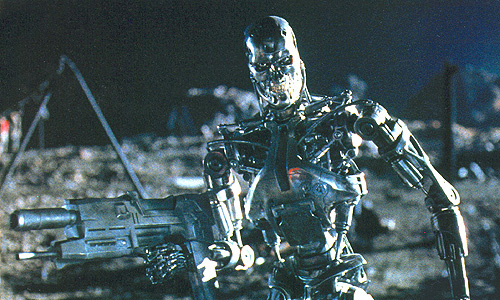
TERMINATOR 3: RISE OF THE MACHINES
In 2003, in a twist of the series, we learn that although the “future is not set”, its ultimate direction has already been decided. The new form, altered in Terminator 2: Judgement Day, is shown in Terminator 3: Rise of the Machines. In this second sequel, we see that events averted in T2 are still imminent, despite attempts to change them. The timing and details have been shifted, but the basic form of Judgment Day still remains.
A decade after Judgment Day was supposed have occurred, a third T-101 assassin robot also reprogrammed to protect the now 22-year-old John Conner (Nick Stahl) in his last days before Judgment Day. After the death of his mother, Sarah Conner, John became a drifter and potential drug abuser, wandering the streets of Los Angeles, avoiding computerization and modernization, fearing that any personal computerized info will be used by other machines to hunt him down.
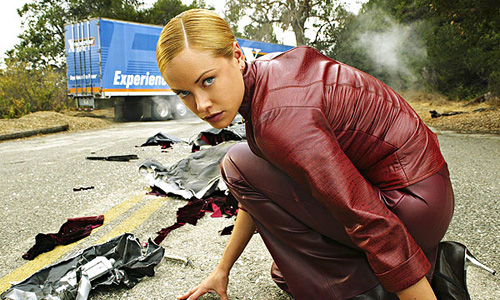
Concurrently, an even more advanced Terminator, the T-X (Kristanna Loken), arrives intent on killing not only John Conner, but all of the leaders of the future resistance against the machines including Kate Brewster (Claire Danes), a key leader and John’s future wife. The T-X, also called the Terminatrix, doesn’t prove to be any more deadly than the T-1000 robot despite being more advanced, although she does have the ability to take control of other computerized machines.
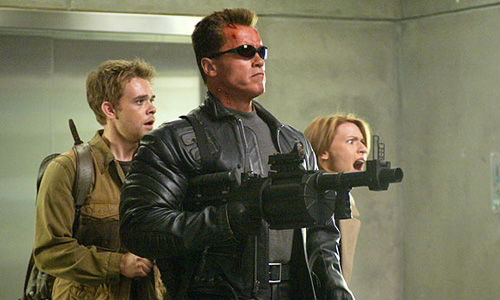
John and Kate learn that this T-850 successfully murdered the future John Conner before being reprogrammed by her to protect him against this third Terminator threat. Rather than fleeing into Mexico, as the Kate of the future intended, the two rush to disable SkyNet before it can order the launch of nuclear missiles. Rather than finding an embedded computer system barricaded into a mountain, they find a well-protected nuclear bomb shelter, stocked and prepared. John and Kate survive the exchange of nuclear missiles that ultimately does wipe out the core of mankind.
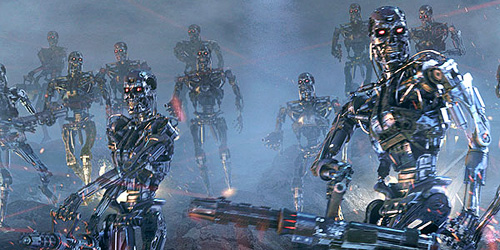
Despite the previous efforts, SkyNet still takes control, only in T3 its form has been altered to be a sophisticated computer virus rather than mass of supercomputers, the original concept having been stopped by the events of T2. In many ways, this film, like Star Wars: Attack of the Clones, serves as a little more than an explanatory display, showing the origins of the futuristic hardware, including smaller versions of the flying Hunter-Killer machines. Although still heavily based in robots chasing a human target, T3 does a marvelous job of laying the foundation for a new series of films, set in a post-apocalyptic world where man struggles for survival against the machines.
COMMENTS: James Cameron wasn’t involved in this third rendition of the Terminator saga. Fans were audibly upset by his lack or participation. Jonathan Mostow maintained a high level of quality and action throughout the story and preserved the style of the original films well enough that this film fits with the first two quite well.
The best insight as to what future movies might be like is shown in Terminator 3-D: Battle Across Time, a Universal Studios theme park ride opened in 1996. This extravaganza, created by Robert Patrick and James Cameron and starring Arnold Schwarzenegger, Linda Hamilton, Edward Furlong, integrates live action, full-scale T-70 robots, and visual displays to portray how Sarah and a young John Conner storm a Cyberdyne presentation to warn the audience of the dangers of SkyNet. Aided by Arnold’s T-800, John and the Terminator travel through a rift in time to battle the T-1 Million and destroy Skynet for good. This showcase is technically spectacular and was at the time, minute for minute, the most expensive film ever made. Although the basic storyline of the ride is ignored in T3, the movie does show a grand view as to what the futuristic world where man battles conglomerations of machines will be like. If the following movies follows this template, they were be spectacular.
The Terminator series has recurrent cameos by its production crew. For example, co-writer William Wisher, Jr. appears both as the police officer who has his patrol car stolen in T1 but also as the stunned photographer who takes pictures of the T-800 in the mall scene in T2. Members of the special effects team made up the workers populating the Cyberdyne company offices. Several victims of the various terminators were also production staff members.
The series also made use of a couple of doubles, including Linda Hamilton’s sister’s, Leslie Hamilton Gearren. She appears twice in T2, first in a deleted scene where Sarah replaces a chip in the T-800 and sees herself in the mirror. Although cut for the theater this scene appears in the special edition DVD. Her second appearance occurs at the end of the film when the T-1000 takes the form of Sarah. Linda actually played the T-1000 and Leslie played Sarah Connor coming up behind the robot. Also of note, during the nuclear holocaust scene, Linda is seen with her real-life son. Most notable of the family members used in the cast occurs in T2, when twin brothers play a security guard and mimicked T-1000. These two are best known for their roles as the US Army censors in “Good Morning Vietnam”.
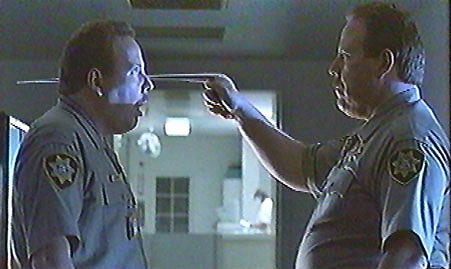
Sadly, the literature of the Terminator series doesn’t closely follow the motion pictures. In the T2 novelization, Judgement Day was completely avoided and Sarah became a grandmother and proud parent of John, who himself became a senator, fighting against the Skynet appropriations bill. Other storylines shown in various comics also conflict with the actual released movies and the novels as well. In the novelization of T2, Sarah and John remove the T-800’s arm from the gear machinery and also throw it into the pit of molten metal. In the comic book representations, these are retrieved and used as a basis for building SkyNet. In T3, we learn that SkyNet’s form was changed to that of an interlocked virus inhabiting most computers in the world. Thus, the future war segments of the Terminator series are likely a little unclear depending on the references one might choose to rely upon.
To create the Terminator “style” a number of recurrent themes are stressed. One is the “crushing foot” motif. This refers to the recurring imagery of humanity being crushed by the machines. First, in the 2029 sequence of T1, there is a close-up of tank treads rolling over human skulls. Next, when the Terminator approaches the house of the first “Sarah Connor,” it crushes a small toy truck. Also, after the Terminator kills Sarah’s friend, he walks over her Walkman headphones. In T2, the title sequence starts with a Terminator endoskeleton crushing a human skull. The imagery of the Hunter-Killer tank rolling over skulls reoccurs. The Terminator crushes one of the roses that falls out of the flower box when it removes the shotgun at the Galleria. Also, the T-1000 treads on the Terminator’s sunglasses at Pescadero State Hospital. Also recurrent are Arnold’s wearing of dark sunglasses and black leather and the portrayal of female heroines as first being soft and feminine, driven by circumstances to become effective partners in combating the machines.
Science fiction author Harlan Ellison, filed a lawsuit after the overwhelming success of the Terminator series claiming that James Cameron had plagiarized several of his short stories, namely “Soldier” and “Demon with a Glass Hand” to develop the idea of robots from the future coming to threaten mankind. Although not listed in the lawsuit, the idea of SkyNet can also be traced to Ellison’s short story, “I Have No Mouth and I Must Scream”. After the lawsuit, newly released prints of T1 acknowledge Ellison and provide him credit, but only for some foundations of the first Terminator movie.
Currently, there is a real CyberDyne Systems company whose homepage is at http://www.cyberdynesystems.com . They are a moderate sized graphics company and not likely to develop hardware to be used in revolutionizing the military. We also have a real SkyNet, that being the AT&T satellite network used for cell phones.
– written by the Two-Brained Cylon
TERMINATOR: THE SARAH CONNOR CHRONICLES
In January 2008, FOX-TV premiered a limited-run series entitled Terminator: The Sarah Connor Chronicles. Set in the time period after the end of T2, the series chronicles the lives of Sarah Connor (Lena Headey, East Enders), John (Thomas Dekker, Heroes), and a “disguised” Terminator defender named “Cameron” (Summer Glau, Firefly) as they prepare for the coming fight while trying to stay hidden from a Terminator sent back to kill John.
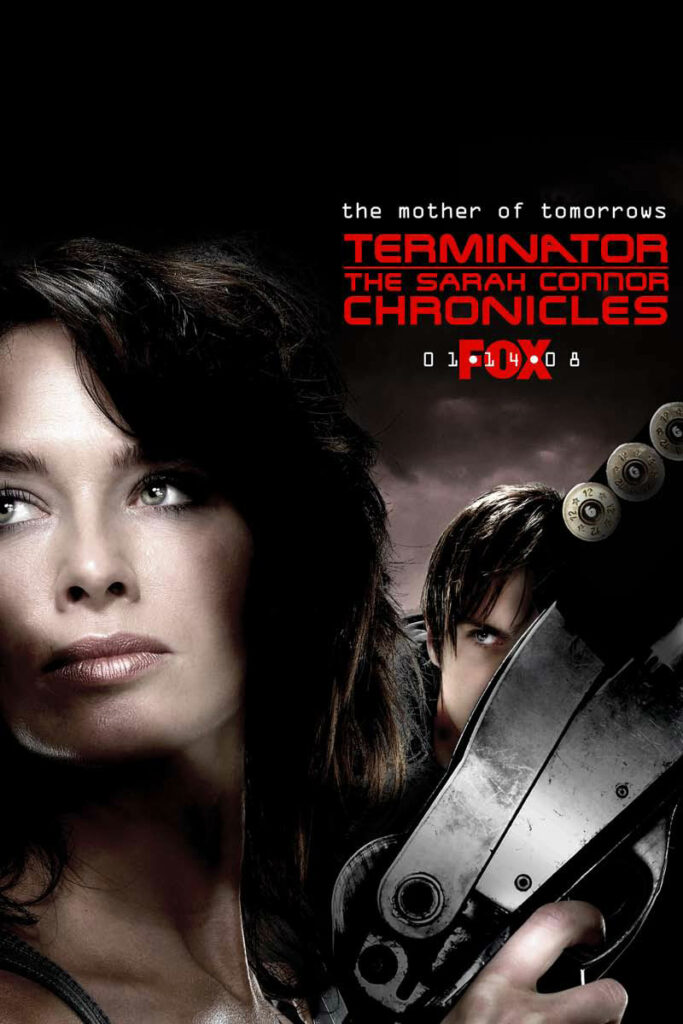
In the pilot, mid-1990’s high-schooler John is discovered by the pursuing T-888 Terminator and rescued just in time by Cameron, who is revealed as a Terminator herself (even re-using the Schwartzenegger line “Come with me if you want to live” from T2). As the T-888 closes in, Cameron leads Sarah and John to a bank, where they discover a machine that will transport them into the future has been built into the vault – it seems the Resistance of the future has been sending back people to help prepare for the coming conflict, and caused the equipment to be built into the vault itself. Also secreted in the vault is an advanced rifle; as the time machine reaches its peak energy the T-888 breaks through the vault door; John shoots it to devastating effect, just as they are transported away.
They wind up in the middle of a street, naked, as cars screech to avoid them. Unnoticed, a flaming Terminator skull bounces across the hood of one car.
They have been transported from the 1990’s to present day in the hope that the Terminator won’t find them. They are at first unaware that a piece of it accompanied them, but as time passes they discover the truth, as it has re-assembled itself.
They also discover that old friends can change, that they must remain vigilant and “off the radar” (much to John’s frustration, being an otherwise normal teen).
They also discover that the Resistance has been sending back fighters, singly and in small groups, to begin the preparations. One of them is the brother of Kyle Reese, although he does not know he is John’s uncle. He is distrustful of Cameron, despite her assistance.
COMMENTS: While the series does take a few liberties with the established storyline, it falls well within the parameters set by the movie series, that much of the future is preordained, yet still changeable. In one example, it is known that Sarah Connor dies of cancer in the early 2000’s – yet she is transported about five years after her known date of death, still healthy – and in time to discover her disease early enough for treatment (although this is only touched on in the pilot episode).
The series successfully mixes the human story with the action, and in the proper proportions. We learn more of the people, of Sarah and her son and the way they must live and develop. Lena Headey is a worthy successor to Linda Hamilton in the role of Sarah Connor.
Thomas Dekker, who played Claire’s friend “Zach” in the first season of Heroes, is well cast as John Connor.
Cameron, Summer Glau’s Terminator character, was named in a not subtle nod to James Cameron, who directed the first two Terminator movies.
Cameron is also a Terminator of “unknown model”, injecting some mystery into the story. We do not know just what her capabilities are.
It is said that another Terminator movie – T4 – will be based in large part on this series.
The initial series ended with a 2-hour finale on 3 March 2008. As of this writing, it is not known if FOX will continue the story. T:TSCC is a worthy entry into the Terminator universe, well produced, well written and well presented. It would be a shame to have it end after such a limited run.
-written by John Pickard